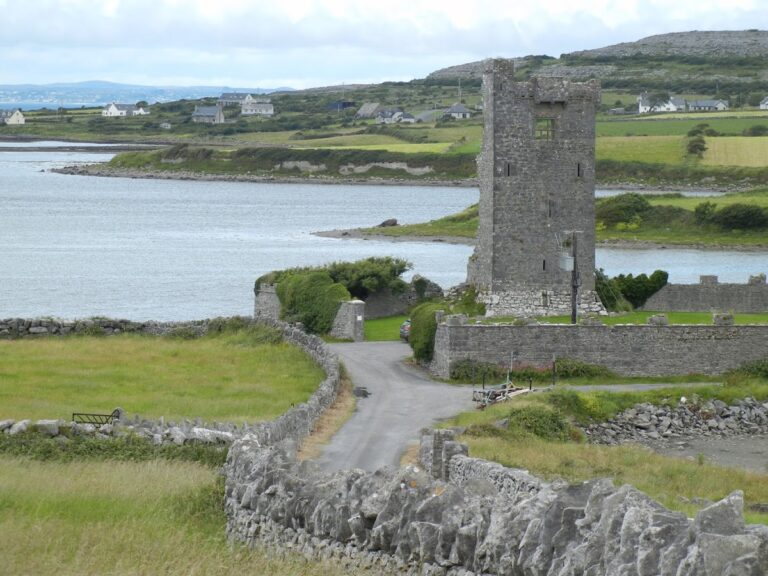Thoor Ballylee: An Irish Tower House Linked to W.B. Yeats
Visitor Information
Google Rating: 4.6
Popularity: Low
Google Maps: View on Google Maps
Official Website: yeatsthoorballylee.org
Country: Ireland
Civilization: Unclassified
Remains: Military
History
Thoor Ballylee, located near the town of Gort in Ireland, is a historic tower house constructed by the Anglo-Norman Burke family in the late medieval period. This family, also known by the name de Burgo, were influential landowners and rulers within the province of Connacht, controlling vast estates that included the Earldom of Clanricarde. The tower was built in either the 15th or 16th century and originally formed part of the estates held by the Earls of Clanricarde.
In the 19th century, the castle was occupied by the Carrig family. By the year 1857, Patrick Carrick was leasing the castle and its surrounding lands from William Henry Gregory, who owned the adjacent Coole Estate. This estate played a prominent role in Ireland’s cultural life, particularly under Lady Augusta Gregory, as it became a gathering place for key figures of the Irish Literary Revival such as W.B. Yeats and John Millington Synge.
W.B. Yeats acquired Thoor Ballylee in 1916 or 1917 for the modest price of £35. Captivated by the tower’s tranquil countryside setting, he undertook a restoration with architect William A. Scott over the following two years. Yeats preserved the original windows on the upper floors while enlarging those on the lower levels to better suit residential needs. From 1921 to 1929, Yeats and his family used the tower as a summer home and a symbol of their rootedness in the Irish landscape. He deliberately changed its name from “castle” to “Thoor,” the Irish word for “tower,” reflecting his devotion to the Irish language and cultural heritage.
Following the departure of Yeats’s family in 1929, the tower gradually fell into abandonment and disrepair. Restoration efforts began anew in 1964, led by Mary Hanley, founder of the Kiltartan Society. With backing from Bord Fáilte, the Irish tourist board, and members of the Yeats family, the tower was opened as a museum dedicated to Yeats in 1965. It contained original furnishings and early editions of the poet’s work. The attached miller’s cottage was adapted into a tea room and shop, a space that was later expanded with additional structures.
The tower’s riverside location near the Streamstown River has exposed it to repeated flooding over the years, including serious events in 1995, 2009–2010, and during Storm Desmond in 2015, causing significant damage. Restoration resumed in 2012 with support from Fáilte Ireland and political advocates such as Senator Lorraine Higgins, aiming to restore Thoor Ballylee’s cultural and educational role. In 2014, the Yeats Thoor Ballylee Society leased the building to manage its revival for Yeats’s 150th birth anniversary in 2015. The tower reopened in June of that year and has been accessible during summers ever since, despite the challenges posed by flooding.
Remains
Thoor Ballylee is a compact, four-story tower house featuring a single room on each level. Its thick outer walls, measuring approximately 2.13 meters (7 feet), provide sturdy support and enclose a narrow spiral stone staircase embedded within the wall. This continuous staircase connects all floors and was of special symbolic importance to W.B. Yeats, who referred to it as “my ancestral stair,” linking him metaphorically to notable historical figures such as Goldsmith, Berkeley, and Burke.
Each floor is illuminated by a window that overlooks the adjacent Streamstown River, which flows alongside the tower, integrating the building with its natural surroundings. On the ground floor, there is a large, wide window providing views over the river, alongside a round-arched doorway providing access to an adjoining thatched building.
This attached outbuilding, historically the miller’s cottage, is a small thatched structure physically connected to the tower itself. Originally serving the miller’s residential needs, it has been repurposed in modern times as a tea room and shop, having also been expanded with an additional building to accommodate visitors.
During W.B. Yeats’s ownership, the tower underwent restoration that preserved the upper windows in their original medieval state, while enlarging the windows on the lower floors to allow more natural light. A commemorative stone tablet affixed to the tower’s exterior wall honors Yeats’s wife George and celebrates the restoration work. The inscription references materials used in the restoration such as old mill boards, sea-green slates, and blacksmith’s work from the local forge, encapsulating a connection to traditional craftsmanship.
Situated near a four-arched bridge dating to around 1825, Thoor Ballylee stands within a rich historical landscape tied closely to Ireland’s literary heritage during the early 20th century. The tower’s preservation and ongoing restoration efforts reflect the continuity of this importance, maintaining the structural and cultural fabric of this rural tower house connected to both Anglo-Norman aristocracy and modern Irish literary history.










